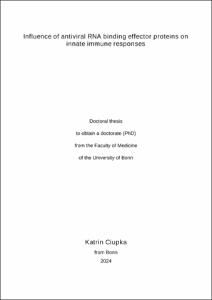Influence of antiviral RNA binding effector proteins on innate immune responses
Influence of antiviral RNA binding effector proteins on innate immune responses
| dc.contributor.advisor | Schlee, Martin | |
| dc.contributor.author | Ciupka, Katrin | |
| dc.date.accessioned | 2024-08-06T14:26:25Z | |
| dc.date.issued | 06.08.2024 | |
| dc.identifier.uri | https://hdl.handle.net/20.500.11811/11778 | |
| dc.description.abstract | The efficient elimination of viruses is initiated by the recognition of the viral nucleic acid genome or replication intermediates through innate immune receptors. Several different receptors specifically detect double stranded (ds) RNA: the RIG-I-like helicase (RLH) family including retinoic acid inducible gene I (RIG-I) and melanoma differentiation-associated protein 5 (MDA5), as well as receptors with direct antiviral activity like protein kinase R (PKR) and oligoadenylate synthetase (OAS) that activates ribonuclease L (RNase L). RLHs are the main interferon (IFN)-inducing receptors and initiate a strong antiviral response, while PKR and OAS/RNase L inhibit host and virus translation once dsRNA is sensed to limit viral replication.
This thesis showed that coactivation of PKR and OAS/RNase L inhibits the RIG-I-induced antiviral cytokine expression after stimulation with long triphosphorylated dsRNA (3P-dsRNA). These results were validated in PKR depleted primary human monocyte-derived macrophages, which demonstrated increased IFNα and interferon-stimulated gene (ISG) induction after stimulation with long 3P-dsRNA compared to wt cells. Polysome profiling showed a global PKR-mediated inhibition of translation when cells were stimulated with long 3P-dsRNA. qRT-PCR analysis of polysome fractions supported that finding, showing the inhibition of translation of CXCL10, IFNB1 and IFIT1 by PKR. The results obtained in this thesis indicate that the dsRNA receptors PKR and OAS/RNase L exert an inhibitory effect on RIG-I-induced type I IFN and ISG expression. The dsRNA-binding protein interferon-inducible double-stranded RNA-dependent protein kinase activator A (PACT) is known to activate PKR and was described to bind to RLHs and modulate their activity. In this thesis, PACT was shown to support the RIG-I-mediated type I IFN induction upon recognition of long dsRNA like polyI:C but intriguingly does not enhance the response to short triphosphorylated dsRNA. Furthermore, it was found to enhance the RIG-I-dependent induction of IP10 during IAV ΔNS1 infection. The findings of this thesis reveal PACT as an important co-factor of RIG-I with clear ligand specificity. An essential feature of the vertebrate antiviral defence is the discrimination between self and non-self nucleic acids. Posttranscriptional modifications of RNAs, such as the cap 1 structure, mark mRNA as self and thus prevent recognition by RIG-I. Some viruses like Yellow fever virus (YFV) exploit this mechanism to circumvent immune recognition. YFV is an arbovirus transmitted by mosquitoes which intriguingly are also able to distinguish between cap 0 and cap 1 structures, as shown in this thesis. Transfection of a synthetic reporter mRNA with a cap 1 structure led to higher reporter protein expression compared to an mRNA with a cap 0 structure. Intriguingly, this difference in expression varied between different cell lines, suggesting that the expression of a potential cap-recognising immune receptor is cell type-specific. Subsequent qRT-PCR analysis demonstrated that the cap structure does not influence mRNA stability in mosquito cells, hinting towards a translational inhibition of cap 0 mRNAs. The findings of this thesis reveal that not only the vertebrate but also the insect immune system is capable of discriminating between self and non-self nucleic acids. In conclusion, the findings obtained in this thesis make an important contribution to the understanding of the interplay between the RNA receptors RIG-I, PKR and OAS/RNase L during viral infections, the action of the co-factor PACT in supporting RIG-I signalling, as well as the detection of viral RNAs in mosquitoes. | en |
| dc.language.iso | eng | |
| dc.rights | In Copyright | |
| dc.rights.uri | http://rightsstatements.org/vocab/InC/1.0/ | |
| dc.subject | PKR | |
| dc.subject | OAS | |
| dc.subject | RNase L | |
| dc.subject | PACT | |
| dc.subject | RIG-I | |
| dc.subject | THP1 | |
| dc.subject | YFV | |
| dc.subject | RNA | |
| dc.subject | CRISPR | |
| dc.subject | Moskito | |
| dc.subject | Rezeptoren | |
| dc.subject | Monozyten | |
| dc.subject | Infektion | |
| dc.subject | Virus | |
| dc.subject | Immunsystem | |
| dc.subject | Angeborene Immunität | |
| dc.subject | Zytokinsturm | |
| dc.subject | mosquito | |
| dc.subject | receptor | |
| dc.subject | monocyte | |
| dc.subject | infection | |
| dc.subject | immune system | |
| dc.subject | innate immunity | |
| dc.subject | cytokine storm | |
| dc.subject | antiviral protein | |
| dc.subject.ddc | 500 Naturwissenschaften | |
| dc.subject.ddc | 570 Biowissenschaften, Biologie | |
| dc.subject.ddc | 610 Medizin, Gesundheit | |
| dc.subject.ddc | 615 Pharmakologie, Therapeutik | |
| dc.title | Influence of antiviral RNA binding effector proteins on innate immune responses | |
| dc.type | Dissertation oder Habilitation | |
| dc.publisher.name | Universitäts- und Landesbibliothek Bonn | |
| dc.publisher.location | Bonn | |
| dc.rights.accessRights | embargoedAccess | |
| dc.date.embargoEndDate | 15.08.2026 | |
| dc.identifier.urn | https://nbn-resolving.org/urn:nbn:de:hbz:5-77628 | |
| ulbbn.pubtype | Erstveröffentlichung | |
| ulbbnediss.affiliation.name | Rheinische Friedrich-Wilhelms-Universität Bonn | |
| ulbbnediss.affiliation.location | Bonn | |
| ulbbnediss.thesis.level | Dissertation | |
| ulbbnediss.dissID | 7762 | |
| ulbbnediss.date.accepted | 27.06.2024 | |
| ulbbnediss.institute | Medizinische Fakultät / Institute : Institut für Klinische Chemie und Klinische Pharmakologie | |
| ulbbnediss.fakultaet | Medizinische Fakultät | |
| dc.contributor.coReferee | Geyer, Matthias | |
| ulbbnediss.contributor.orcid | https://orcid.org/0000-0002-8283-7597 |
Dateien zu dieser Ressource

Dieses Dokument ist zur Zeit gesperrt.
Das Dokument erscheint in:
-
E-Dissertationen (2059)



